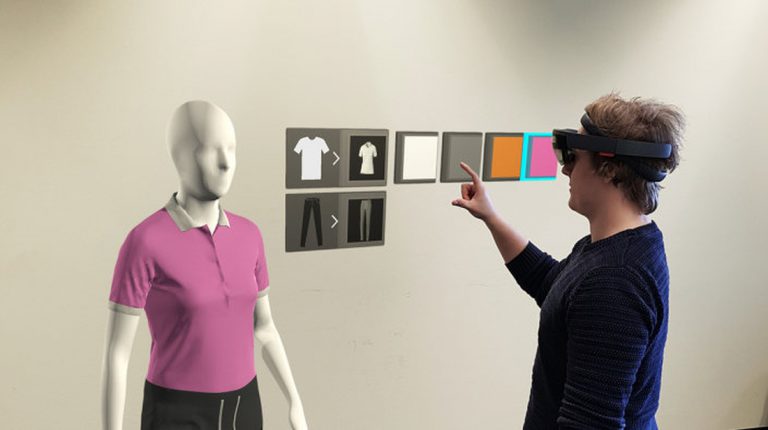A few years ago I was introduced to Virtual Reality and 360˚ video. When I saw the VR glasses, it seemed to me a lot of hassle to put that bulky device on your head and control it, but that turned out to be easy. More importantly: I was fascinated by the content I was shown! Within no time I felt present in the film and I was part of the situation in the scene.
As a director of corporate films and television programs, I am used to shaping a story within the familiar 16: 9 frame. Within this frame I can determine what a viewer gets to see and how: for example, do I opt for a total shot or a close-up or perhaps for both? In the editing I then decide when to show that particular close-up. The image frame and the editing, combined with a good script of course, are the most important tools to tell a film story. But what if the boundaries of a picture frame are completely missing and the editing is actually kept to a minimum?
Angry customer…
During one of my first VR experiences, I ended up in a British Telecom store. There a dissatisfied customer addressed me with a complaint about a product and I was asked what my reaction would be. I am not a store employee in daily life and never have been, so perhaps not completely illogical, I chose the wrong answer from the options offered to me. As a result, the customer was not happy to say the least and reacted irritably. On me personally! At least that’s how it felt. What now? The angry customer continued to look at me questioningly. I avoided her gaze by looking around me and as a bonus I got a meaningful look from another customer who was curious to see how I was going to solve this situation. Fortunately, I was able to correct it with the next, better chosen answer.
As mentioned, I was immediately fascinated, because I felt the effect. You can’t just look away from a screen or take a sip of coffee, you are completely focused. And your brain switches quickly: almost immediately you feel physically present in the virtual environment in which you are placed and you respond naturally to what is happening there.
In VR, or rather, in 360˚ video, it is not the frame or the montage that is the weapon, but the power of this new medium lies in the fact that you completely immerse someone in a very realistic feeling situation. It is interesting to see how you can use this specific power. Where can VR actually add value. Where does it go beyond the wow effect that most people will experience when they first put on such glasses. The technique itself is nice to get acquainted with, but personally I don’t really care. Very simple, I just want it to work. But admittedly, I am not really a gadget man. I am particularly curious about what the actual impact is on the viewer and how you can use it to bring about a change in this viewer. By the way, the question is whether „viewer“ is the right word, since you are not simply looking at something, but rather experience it (it is a bit far-reaching to say that you create experience experts with VR, but still …).
Training in VR
If there is one area in which VR is developing at lightning speed, it is in the field of training. In the US in particular, developments are now going fast. The most appealing use case at the moment is that of the Californian company STRIVR. Their customer Walmart, with 1.5 million employees the largest employer within the US, has distributed no less than 17,000 Oculus Go glasses across their 4,700 locations throughout the country and now offers all its employees a total of more than 50 training modules. This includes shop training in the areas of customer service and safety, onboarding programs, but also leadership programs and simulations of bad news conversations (see also: How VR is Transforming the Way We Train Associates). At another major STRIVR customer, Verizon, the entire store staff underwent armed robbery training last year. In this training, people are placed in a number of realistic, high-impact robbery scenarios and so experience what it is like to be treated with verbal violence and to get a potentially deadly weapon aimed at you. By having practiced this several times in this pervasive way, participants appear to be able to respond less stressfully to robbery situations and know how to follow the correct procedures at these dangerous moments.
In addition, developments in the Netherlands are also moving fast now. The Delft-based company WARP has developed an extensive interactive VR tool in which customers can develop their own training scenarios and post content. Customers such as BT, CSU and KLM make use of this.
VR assessment
MTVR produced the first fully-fledged, validated VR assessment in the Netherlands for and with eelloo / VanderMaesen|Koch / SlimAssessments, in which you, as a participant in a team meeting are placed in a realistic work situation. Here you experience the interaction of a group of people with different roles, interests and characters. You observe the group process by actively looking around you and you assess the behavior by answering questions. These answers are scored and processed into a report with standardized results. VR assessment is about individual behavior and group processes and can be used as a stand-alone instrument or as part of a larger assessment program.
Safe
Difficult to imitate, unsafe situations or circumstances can be practiced safely using VR. Consider, for example, employees of security services, who are placed in a simulation, escalating in an increase in violence, fire and the like, or store personnel who are confronted with aggressive customers or are threatened with a weapon. VR also offers another kind of safety, namely a degree of social safety: people can train individually, without having to do this in a role play, under the eyes of colleagues. The focus is directly on the content of the training and one is not distracted and negatively influenced by any feelings of embarrassment.
Effective
In VR people can be placed in a real-life work situation, even in logistically difficult to simulate or aforementioned dangerous circumstances. In VR, these circumstances only have to be set up or filmed once and then they can be practiced without limit and without risk. Consider training people within large construction companies. During training sessions, they can visit various large construction sites anywhere in the world, where they can look for safety procedure errors, for example, within the interactive VR experience.
In pre- or onboarding programs, new employees become acquainted with colleagues and can look around the company, while going through induction or compliance-related procedures. Employees can get to know colleagues at other locations, wherever they are in the world, look around and are confronted with cultural differences. Companies can reduce their ecological footprint because it is becoming less necessary to get people on a plane. Themes such as inclusiveness, integrity and sexual behavior can be brought to the attention in a very direct way in VR.
Completely submerged
Immersive learning means without distraction, 100% focus training with the result that the material offered is up to 40% better remembered. You make choices in realistic situations, in which you also directly experience the effect of those choices with the help of interactive scenarios. You learn by doing!
Scalable and cost efficient
VR makes it possible to train anywhere and whenever it suits you. Glasses at the work location can be used independently at a quieter moment of the day in terms of work. VR training courses can be repeated, if necessary unlimited. You can simulate difficult circumstances once. Situations that cannot be practiced in real life due to security risks or financial feasibility become widely accessible. That applies to training in VR anyway: because of the cost efficiency, many more employees can be trained, from trainees to management.
A lot of money is spent by companies on testing, onboarding and training their employees. Certainly at companies where staff turnover is high. The biggest gain from deploying VR is in time. People in VR need less time to learn the same material and staff do not necessarily have to travel to an external training facility. This saves considerably in the loss of workable hours and on travel costs. Moreover, one can do VR training at quiet times of the day and be flexible in that. Trainers need to be hired less and they also do not have to travel through the country. Role play actors are hired on a one-off basis and hiring multiple actors to create simulations in a group context is therefore more feasible.
Data insights
VR offers infinite possibilities in collecting valuable information: who has completed the training, how long has it taken to fulfill it and what are the results? How do women perform compared to men or MT members compared to other staff? Where do we see people improving? The use of eye tracking is also possible, in which it is measured what a participant is looking at and at what moment. Based on the data, follow-up discussions can be held about choices made or other findings, which gives training more value for employee and company.
What answers have come back to any feedback questions. What did people think of the training?
Don’t see VR as a trial
For the time being, VR is often used only as an experiment. An organization can show to the outside world, or internally to its employees and management, that it’s actively working on innovation. The emphasis is on innovation and not on the added value of the deployment of VR. Organizations do not really invest in the medium. And that’s a shame, because to use VR effectively you will have to take it seriously and especially look at a sustainable commitment (as with the aforementioned Walmart example).
Go for quality
A VR experience stands or falls on quality. To start the content. If you place people in a super realistic environment, then what is happening there must also look lifelike and credible. VR content, made by inexperienced directors, with actors of a high amateur level results in more substitute shame for the user (after all, you feel part of the situation …), rather than being immersed in the content of the scene in a compelling way. And VR is also not compelling if the sound is not optimally recorded and hollow, distant and therefore doesn’t sound realistic. In addition, it also doesn’t help if a film set is not properly lighted, so that you are not able to properly perceive facial expressions when people have a window in the background or are positioned in a shadow. So: good actors, good direction, lighting and audio are conditions for creating credible high-end content that can achieve its goals.
To guarantee quality, it is also necessary to look carefully at how VR is implemented in an organization. In larger organizations in particular, it is advisable to involve potential stakeholders in the process from the outset. Think of departments such as HR, IT, Legal, Marketing & Communication and Facility Services.
VR not the one and only solution
Of course, VR is not always the best option for all forms of training, onboarding or assessing people, but in many cases it will at least be a very valuable addition to existing programs and procedures, both in terms of content and in terms of cost savings. And in many cases, immersive learning will indeed be a better and more effective method than traditional one-on-one training or e-learning courses. So it’s worth looking at where time and money is being wasted within the organization. Which training courses would you like to be able to repeat and / or practice more often, but is that impossible or not feasible in practice? Or what training courses would you like as a company to have many more people do?
10 benefits in a row
- Many more employees can follow the same training. So these are not only reserved for managers or a limited selection of employees. By offering modules, differences can be made per trainee in the content offered.
- Repeatable: the possibility to go through a training several times and the chance to improve yourself.
- No distraction, so 100% focus.
- Actors only have to be hired once, making it more feasible to simulate situations in a group context with multiple actors.
- Choices, answers and other interactions are measured and can be supplied in the form of reports. It shows who has gone through a training course and when. And if this has happened several times, whether there has been an improvement in the results.
- Not looking at a screen, but actively undergoing, experiencing and doing.
- Simulations that are difficult to imitate in real life training situations because of location (for example, a construction site, etc., amount of actors required, travel time) can be set and experienced once.
- Safe, both practical and social.
- People remember up to 40% better in less time.
- Gain of time: training itself costs less time to do. Employees do not necessarily have to go to an external location and can do training when it suits them and this means less loss of workable hours.
Quelle:
https://www.linkedin.com/pulse/power-vr-immersive-learning-effective-fascinating-patrick-dierdorp/?trackingId=r5bvkPAJ3QulgoDByEBDuA%3D%3D




